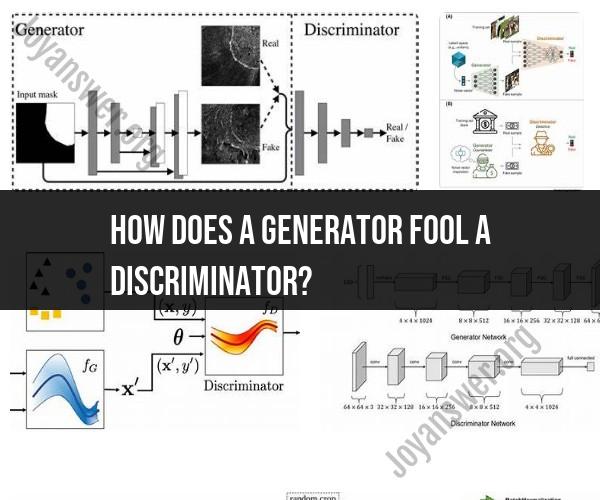How does a generator fool a discriminator?
In the context of machine learning and artificial intelligence, the terms "generator" and "discriminator" are often associated with Generative Adversarial Networks (GANs), a class of neural networks used for tasks such as image generation and data synthesis. GANs consist of two neural networks: a generator and a discriminator, which are trained in a competitive manner. Here's how a generator can attempt to fool a discriminator:
Background on GANs:
- GANs are composed of two neural networks:
- Generator: The generator's role is to generate data samples, such as images or text, that resemble real data as closely as possible.
- Discriminator: The discriminator's role is to differentiate between real data and data generated by the generator. It tries to classify whether an input data sample is real (from the dataset) or fake (generated by the generator).
- GANs are composed of two neural networks:
Training Process:
- The generator and discriminator are trained iteratively in a "game" where they try to outperform each other.
- During training, the generator aims to produce data samples that are increasingly difficult for the discriminator to distinguish from real data.
Generator's Role in Fooling the Discriminator:
- The generator starts by producing random data samples, which are typically far from resembling real data.
- As training progresses, the generator adjusts its parameters to improve the quality of the generated data.
- The generator uses feedback from the discriminator to make these adjustments.
- The generator strives to generate data samples that are so realistic that the discriminator cannot confidently classify them as fake.
Continuous Feedback Loop:
- The competition between the generator and discriminator creates a continuous feedback loop.
- The generator attempts to produce data samples that minimize the discriminator's ability to distinguish real from fake.
- The discriminator, in turn, adapts to become better at distinguishing real from generated data.
- This iterative process continues until the generator produces data that is increasingly difficult for the discriminator to classify correctly.
Equilibrium:
- In an ideal situation, the training process reaches an equilibrium where the generator generates data that is very similar to real data, and the discriminator cannot consistently distinguish between real and generated data.
Achieving Realistic Outputs:
- The ultimate goal is for the generator to produce data that is so convincing that it is virtually indistinguishable from real data. At this point, the GAN has successfully "fooled" the discriminator.
It's important to note that the success of a GAN depends on various factors, including the architecture of the networks, the quality and quantity of training data, and the training process itself. Achieving realistic outputs while training a generator can be a challenging task, and it often requires fine-tuning and experimentation to reach the desired level of realism. GANs are widely used in applications such as image generation, style transfer, and data augmentation, among others.
The Art of Signal Processing: How Generators Fool Discriminators
In signal processing, a generator is a device that produces a signal. A discriminator is a device that distinguishes between different types of signals. Generators can be used to fool discriminators by producing signals that are similar to the signals that the discriminator is expecting, but which are actually different. This can be done for a variety of purposes, such as to improve the performance of a system or to deceive someone.
One way to fool a discriminator is to use a generator to produce a signal that has the same frequency and amplitude as the signal that the discriminator is expecting, but which has a different phase. This can be done by using a phase-shift circuit. When the generator and the discriminator are in phase, the discriminator will output a high signal. When the generator and the discriminator are out of phase, the discriminator will output a low signal. By adjusting the phase of the generator, it is possible to fool the discriminator into thinking that the signal is coming from a different source.
Another way to fool a discriminator is to use a generator to produce a signal that has the same frequency and amplitude as the signal that the discriminator is expecting, but which has a different waveform. This can be done by using a waveform synthesizer. When the generator and the discriminator have the same waveform, the discriminator will output a high signal. When the generator and the discriminator have different waveforms, the discriminator will output a low signal. By adjusting the waveform of the generator, it is possible to fool the discriminator into thinking that the signal is coming from a different source.
Generators can also be used to fool discriminators by producing signals that are a combination of different frequencies. This can be done by using a mixer. When the generator and the discriminator are tuned to the same frequency, the discriminator will output a high signal. When the generator and the discriminator are tuned to different frequencies, the discriminator will output a low signal. By adjusting the frequency of the generator, it is possible to fool the discriminator into thinking that the signal is coming from a different source.
Generators can be used to fool discriminators in a variety of applications. For example, generators can be used to improve the performance of communication systems by reducing noise and interference. Generators can also be used to deceive radar systems by producing signals that appear to be coming from different targets.
Generator Signals and Discriminator Response: Understanding the Dynamics
The dynamics of generator signals and discriminator responses can be complex and depend on a variety of factors, including the type of generator, the type of discriminator, and the operating conditions. However, there are some general principles that can be applied.
One important principle is that the discriminator will respond to the generator signal if the generator signal is within the discriminator's frequency range and amplitude range. The discriminator will also respond to the generator signal if the generator signal has the same waveform as the signal that the discriminator is expecting.
Another important principle is that the discriminator's response will be stronger if the generator signal is closer to the center of the discriminator's frequency range and amplitude range. The discriminator's response will also be stronger if the generator signal has the same waveform as the signal that the discriminator is expecting.
Finally, the discriminator's response will be affected by noise and interference. Noise and interference can cause the discriminator to respond to signals that are outside of the discriminator's frequency range and amplitude range. Noise and interference can also cause the discriminator to respond to signals that have different waveforms than the signal that the discriminator is expecting.
Deceptive Signals: How Generators Confound Discriminators in Electronics
Generators can be used to create deceptive signals in a variety of ways. For example, a generator can be used to create a signal that appears to be coming from a different source. This can be done by using a generator to produce a signal that has the same frequency, amplitude, and waveform as the signal that the discriminator is expecting, but which is actually coming from a different source.
Generators can also be used to create signals that are difficult for discriminators to detect. This can be done by using a generator to produce a signal that is outside of the discriminator's frequency range and amplitude range or by using a generator to produce a signal that has a different waveform than the signal that the discriminator is expecting.
Generators can also be used to create signals that are designed to confuse discriminators. This can be done by using a generator to produce a signal that is a combination of different frequencies or by using a generator to produce a signal that is constantly changing frequency and amplitude.
Generators are a powerful tool that can be used to fool discriminators in a variety of ways. By understanding how generators work and how discriminators respond to signals, it is possible to create deceptive signals that can be used for a variety of purposes.












